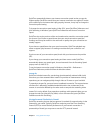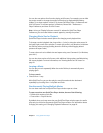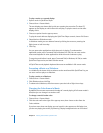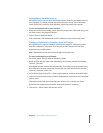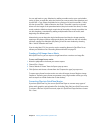
Chapter 1 Using QuickTime Player 21
Using Frame Number and Time Codes
When you’re viewing a movie in QuickTime Player, you can display the current movie
time or frame number, or the SMPTE time code if the movie has a time code track.
(Some applications, such as Final Cut Pro, automatically add a time code during
capture.)
Displaying Frame Numbers, Movie Time, or Time Code
The area next to the timeline in QuickTime Player displays the time information for the
current movie.
1 Click the time display area.
2 Choose an option from the pop-up menu that appears:
 Standard: Displays movie time in HH:MM:SS format.
 Time Code: Displays the movie’s time code in HH:MM:SS:Frame format. Either the
time code or drop-frame time code will be displayed, depending on the frames per
second of the movie. A colon in the frame segment of the time notation indicates
that a non-drop time code is being displayed. A semicolon indicates a drop-frame
time code. If the movie has a time code track, it will be used. Otherwise, the time
code will be calculated from 00:00:00:00 at the start of the movie.
 Frame Number: Displays the frame number, incrementing from 0 at the start of the
movie. An “f“ in the time display area indicates that the frame count is being
displayed.
Navigating a Movie by Frame Number or Time Code
You can jump to a point in a movie by entering a specific frame number or time code.
 Double-click the time display, and then press the arrow keys or type a new time or
frame number.
 To select the entire time display, double-click the area, or click the area and then
press Command-A (in Mac OS X) or Control-A (in Windows).
To enter a time, separate each unit with a period. For example, 5.02.10 will go to five
minutes, two seconds, and 10 frames. To go to five minutes, zero seconds, and 10
frames you can enter 5..10.




